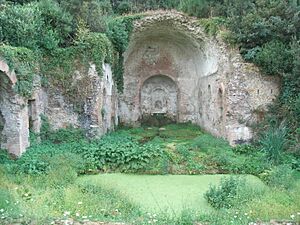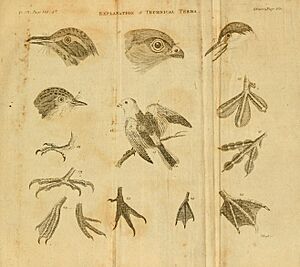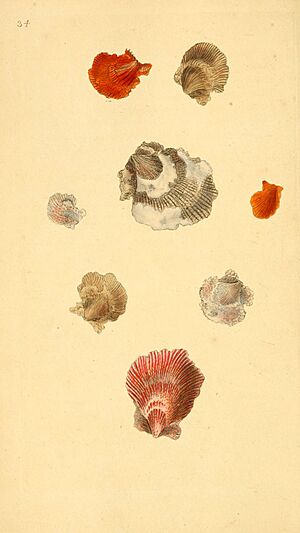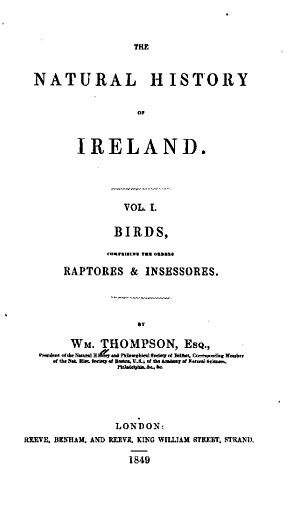William Thompson (naturalist) facts for kids
Quick facts for kids
William Thompson
|
|
|---|---|
 |
|
| Born | 2 December 1805 |
| Died | 17 February 1852 (aged 46) |
| Known for | Ornithologist, marine biologist, and author |
William Thompson (born December 2, 1805 – died February 17, 1852) was an amazing Irish naturalist. He is famous for his important studies about nature in Ireland. He especially loved studying birds and sea creatures.
Thompson wrote many notes about birds. He described where they lived, how they nested, their eggs, songs, and what they ate. These notes became his big four-book series called The Natural History of Ireland. Other scientists used his work a lot.
Contents
Early Life and Discoveries
Thompson was born in Belfast, Ireland, a busy city by the sea. His father was a rich linen merchant. This wealth allowed William to pay for his own research. He did not need to work for a university.
He went to the Royal Belfast Academical Institution. There, he studied Biological Science. This school was strong in natural history. It helped many famous naturalists get their start.
In 1826, Thompson went on a big trip around Europe. He visited countries like the Netherlands, Belgium, Switzerland, and Italy. He especially liked a place near Rome called the Nympheum of Egeria. It had old stories and poems connected to it.
Soon after, in 1827, he joined the Belfast Natural History Society. His first science paper was published then. It was about The Birds of the Copeland Islands.
A Naturalist's Daily Life
William Thompson had a very organized life. Every morning, he spent four hours on his science work. This included research, writing for books, and answering letters.
After that, he would exercise for a few hours. The time between dinner and tea was for reading about current events. If he didn't have meetings, he would do more science work in the evening.
In spring, he often visited London. There, he enjoyed literature, history, and art, as well as science. He also traveled to beautiful parts of England and Scotland. In summer, he went to the seaside with his family. In autumn, he toured with friends and attended science meetings.
Important Research Work
Thompson shared his up-to-date information about Irish birds. He wrote for several important science magazines. These included The Magazine of Zoology and Botany and The Annals of Natural History.
In 1840, he made the first full list of Ireland's birds. This was for a big science meeting in Glasgow. He also published other works, mostly about birds. These papers became the foundation for his most important book.
His big work, The Natural History of Ireland, came out in four books. They were published between 1849 and 1851.
Studying Birds
Thompson had a huge library of bird books. He also used his own bird collections. He looked at collections in museums in Belfast and Dublin.
One of his main bird works was a report from 1841. It compared the animals of Britain and Ireland. Thompson noticed that most birds found in Britain also lived in Ireland.
His book, The Natural History of Ireland, has a special section on birds. It reads like a story and shares many facts. It talks about how birds look, how they act, where they nest, and when they appear.
Thompson found many rare bird species in Ireland. He worked with a network of people who helped him. For example, he recorded the first times Bonaparte's Gull and American Bittern were seen in Ireland. He was also careful to check facts. He noted that some people called common birds like buzzards "Kites."
Exploring Sea Life
In 1834, Thompson started studying sea animals. He wanted to know where they lived in the ocean (how deep) and when they appeared (what season).
He worked with another scientist, Edward Forbes. They used a special tool called a dredge to collect sea creatures from the Irish Sea. Other friends and scientists also joined them.
In 1841, Thompson went on a long trip on a ship called the Beacon. He traveled with Forbes in the Mediterranean and Aegean Sea. This trip lasted 18 months. They used the dredge over 100 times, at different depths. They also studied creatures on the shore.
Thompson focused on how deep different types of algae (sea plants) lived. His main collection of algae is now in the Ulster Museum. It has many specimens he collected himself.
Later Years and Legacy
Thompson wrote many letters to other naturalists. He shared information about nature with scientists in Britain and Ireland. As he became more famous, people all over Ireland sent him information.
Around 1847, when he was 42, his health got worse. He had heart problems. In 1852, William Thompson died of a heart attack in London. His friends, including famous naturalists like William Yarrell and Edward Forbes, were with him. He never married.
After he died, parts of Thompson's letters and notes were put together. They became the fourth book of The Natural History of Ireland. This book was about invertebrates (animals without backbones) and other animals. It was published in 1856, four years after his death.
Selected Works
Thompson wrote over eighty scientific papers and books. Here are a few examples:
- 1837: On the Pollan (a type of fish) of Lough Neagh.
- 1833: About a young Long-tailed Manis (a mammal) from Sierra Leone.
- 1833: On finding the young Arctic Tern in Northern Ireland.
- 1834: Notes on the cuckoo.
- 1835: About tiny sea creatures that damage wood in the British Isles.
- 1839: On a new type of fish related to the Cusk-eel.
- 1841: A report on the animals of Ireland, especially vertebrates (animals with backbones).
- 1846: About a bottle-nosed whale found in Belfast Bay.
Thompson was a member of the Zoological Society of London. He was also a corresponding member of other important science groups in the United States.
Species Named After William Thompson
Several species have been named to honor William Thompson and his work:
- Lepeophtheirus thompsoni (a type of sea louse)
- Acipenser thompsoni (a type of sturgeon fish, now known as Acipenser sturio)
- Bulimus thompsoni (a land snail)
- Thaumantias thompsoni (a type of jellyfish)
- Meloscira thompsoni (a type of algae)
- Spirillum thompsoni (a type of bacteria)
- Dolichospermum thompsoni (a type of algae)
- Pterinea thompsoni (a fossil shell)
- Hypoplita thompsoni and Pagurus thompsoni (types of crabs)





